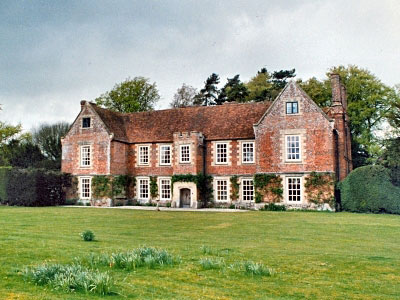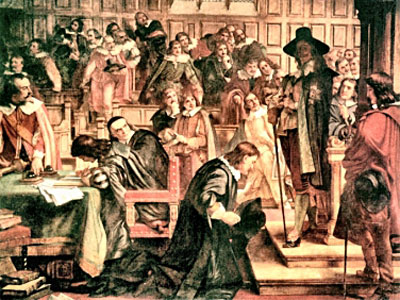JOHN HAMPDEN – THE PATRIOT
“A gallant man, an honest man, an able man”
You can jump to any of the four parts using these links:
Part I – Early Days | Part II – The Statesman | Part III – The Soldier | Part IV – Reputation

Part I – Early Days

John Hampden was descended from an ancient Buckinghamshire family of great wealth with a long tradition of service to the Crown. The Hampdens had lived at Great Hampden (left), high up in the Chilterns, since before the Norman Conquest, and had provided Members of Parliament, High Sheriffs, and courtiers throughout the centuries.
One of Hampden’s ancestors, Sir John Hampden ‘of the Hill’, rode in the train of the English Queen at the Field of Cloth of Gold in France in 1520. Another relative, Richard Hampden, was Queen Elizabeth I’s Clerk of the Kitchen and his sister, Sybil Penn, was nurse to the future King Edward VI. John’s grandfather Griffiths, who was an MP and later High Sheriff of the county, entertained Queen Elizabeth I and her Court at Great Hampden.
Had John Hampden wished he could have purchased advancement in the court, but he chose instead to resist Charles I’s arbitrary government. As a result he earned the title, ‘Patriae Pater‘ – the Father of the People.


John Hampden was born in 1595, probably in London, son of William Hampden and Elizabeth Cromwell, daughter of Sir Henry Cromwell of Hinchinbrooke. Thus John and his younger brother Richard, born in 1596, were first cousins to Sir Henry’s grandson Oliver, later to become Lord Protector of England, Scotland and Ireland.
Because of Willam Hampden’s early death, when his elder son was only 3 years old, John and his brother were brought up by their mother, who sent them to be educated at Lord Williams’s Grammar School, Thame.

In 1609 John Hampden entered Magdalen College, Oxford, and it was probably here that he met his lifelong friend Arthur Goodwin. Together they collaborated in a book of Latin verses entitled Luctus Posthumus to mark the death of Henry, Prince of Wales in 1612, and the following year in another anthology entitled Lusus Palatini to commemorate the marriage of Princess Elizabeth to the Elector Palatine. In 1613 Hampden entered the Inner Temple to study law.
Two years after his marriage to Elizabeth Simeon in 1619, Hampden entered Parliament as Member for Grampound in Cornwall. He quickly gained the confidence of Sir John Eliot with whom he kept up a long and affectionate correspondence when Eliot was imprisoned in the Tower.
Part II – The Statesman

Hampden himself was imprisoned in 1626 for refusing to subscribe to a forced loan, but it was in 1635, when the Ship Money tax was extended to the inland counties, that he made his great stand against tyranny. Despite being one of the wealthiest landowners in the country, he refused to pay the levy, and was summoned for the assessment of 20 shillings on his Stoke Mandeville lands.
The case aroused great public interest and, although the verdict went against Hampden by the narrowest of margins (7-5), it was a great moral victory. The decision, wrote the historian Clarendon (a contemporary of Hampden), “proved of more advantage and credit to the gentleman condemned than to the King’s service” and the reasoning of the judges “left no man anything he could call his own”.

John Hampden was now at the height of his fame, and occupied much the same position in the eyes of the people as did his descendant Winston Churchill exactly 3 centuries later. Because of Hampden’s stand, the King had subsequently been unable to collect Ship Money, and had been forced to recall Parliament in 1640, after an interval of 11 years.
“When this parliament began”, wrote Clarendon, “the eyes of all men were turned on him as their Patriae Pater, and the pilot that must steer their vessel through the tempest and rocks which threatened it”. It was from this event that John Hampden received the title by which he has ever since been known – ‘The Patriot‘.

Hampden was a tireless worker, sitting on numerous parliamentary committees, and he played an important part in the impeachment by the House of Commons of the King’s Chief Minister, the Earl of Strafford, for high treason. His greatest skill, however, lay in his ability as a tactician and in his persuasiveness. When, in the Short Parliament of 1640, the King demanded twelve subsidies in return for abolishing Ship Money, Hampden proposed “That the question might be put whether the House would consent to the proposition made by the King as it was contained in the message”, to which the answer “No” was inevitable.

Similarly, when a quarrel broke out in the House in the early hours of the morning over the printing of the Grand Remonstrance, Hampden averted bloodshed by “a short speech of great sagacity and calmness”. He was also a shrewd judge of character, recognising the potential of his cousin Oliver Cromwell when the future Lord Protector was still a humble back-bencher.
As one of the Five Members, Hampden narrowly escaped arrest by the King on a charge of high treason in January 1642. The incident appears to have strengthened his militancy, for it was he who proposed that the King place the Tower, the Militia, and the principal forts in Parliament’s hands. When Charles’s refusal made war inevitable, Hampden was appointed to the Committee of Safety – the Parliamentary War Cabinet.

Part III – The Soldier

On the outbreak of the Civil War, John Hampden and his lifelong friend Arthur Goodwin raised a regiment of foot and horse respectively from their Buckinghamshire and Oxfordshire tenants. Tradition has it that the muster took place on Chalgrove Field. Hampden’s regiment were known as ‘The Greencoats’ from the colour of their jackets.
As Deputy-Lieutenant for Buckinghamshire one of Hampden’s earliest actions was to arrest the Earl of Berkshire and the King’s Commissioners of Array. He then took part in the relief of Coventry but missed Edgehill as his regiment was escorting the artillery train.
Hampden’s eagerness, as a soldier, to pursue any military advantage was allied to his refusal, as a politician, to accept any peace on unfavourable terms. “Without doubt”, wrote Clarendon, “when first he drew the sword he threw away the scabbard”
Hampden was privately critical of the Earl of Essex’s strategy, feeling that he should attack Oxford, but as Essex’s Chief of Staff he supported the Lord General (left) loyally, taking part in the siege and capture of Reading. He was even spoken of as a possible successor to the lackadaisical Earl.


When Essex finally moved against Oxford and quartered his army at Thame, the King’s nephew Prince Rupert (above right) led two thousand men out of the city in a night sortie, beating up the Parliamentary outposts at Postcombe and Chinnor, before turning southwards towards Chalgrove and Stadhampton.


Sending a message to Essex requesting him to cut off the Prince’s retreat at Chislehampton Bridge, Hampden, who had probably been visiting the Parliamentary outposts, rallied the various bodies of troops that had been skirmishing with the Royalist rear and pursued them with vigour.
The following morning, Sunday 18th June 1643, Rupert halted his main body on Chalgrove Field and ambushed the small Parliamentary force. Hampden placed himself at the head of a troop of horse and led a counter-attack, but in the ensuing battle, he was fatally wounded.
Accompanied by the faithful Goodwin he rode to Thame, where he died on his wedding anniversary, 24th June, in the house of Ezekiel Browne, later to become the Greyhound Inn.

John Hampden’s body was escorted back to Great Hampden by his beloved Greencoats, and he was buried among his ancestors in the Church of St. Mary Magdalene.
Hampden’s character and abilities were praised by friend and foe alike. “Never Kingdom received a greater loss in one subject”, wrote one contemporary, and Clarendon said that he had “the most absolute faculties to govern the people of any man I ever saw”.

Perhaps John Hampden’s character and achievements were best summed up by his oldest friend, Arthur Goodwin, who wrote, “he was a gallant man, an honest man, an able man, and take all, I know not to any man living second… I would lay it to heart that God takes away the best amongst us”.

Part IV – Reputation
To be written













